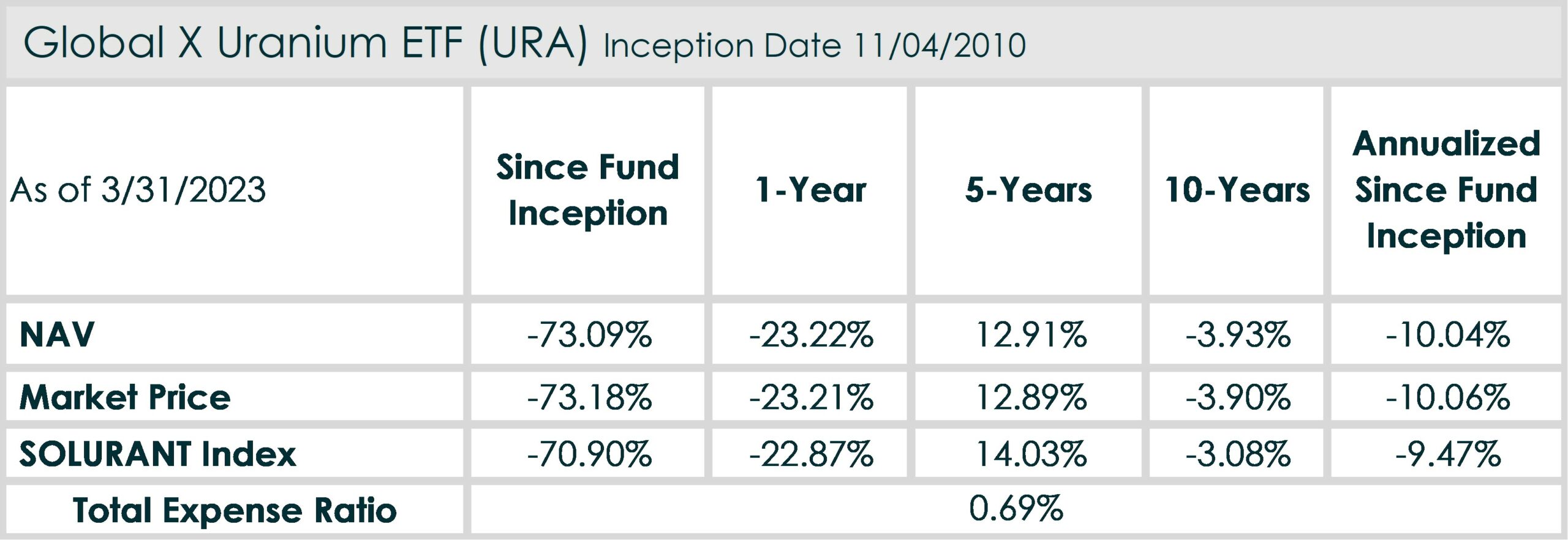The Q1 2023 Uranium Quarterly Report can be found here, offering insights on nuclear and uranium news and performance of the Global X Uranium ETF.
Key News of the Quarter
- Uzbekistan government intends to engage in uranium production. The president recommended an acceleration of “cooperation projects” to improve the effectiveness of mining and processing and seek new resources.1
- Japan continues its shift back to nuclear. A framework for running nuclear power facilities for more than 60 years was adopted at a meeting of Japan’s Nuclear Regulation Authority.2
- France is mobilizing a pro-nuclear alliance to safeguard its nuclear sector. France wants the nuclear industry in Europe to be seen as a vital factor in the continent’s ability to compete with the US and China.3
- EU concurred that nuclear power could help achieve the challenging climate objective. According to the EU Commission’s definition of net-zero, advanced nuclear technologies meet all current environmental regulations within the EU. The agreement enables nations like France and Sweden to cut their green hydrogen ambitions for the industry by a fifth by 2030 if they primarily produce the remaining hydrogen using nuclear power rather than fossil fuels and continue to reach their total renewable goals.4
- Finland’s Olkiluoto 3 (OL3) nuclear reactor began to produce regularly after 18 years. The largest nuclear reactor in Europe started production regularly, according to its operator. This increased energy security in an area where Russia has cut off gas and power supplies. 5
- UK is committed to nuclear and is undertaking multiple steps. To improve economic growth and energy independence, the UK wants to speed up nuclear planning.6 According to a recent strategy paper, the UK government is committed to a schedule of new nuclear projects beyond Sizewell C, offering industry and investors the confidence they need to implement projects quickly.7 New nuclear plants are expected to increase the UK’s nuclear generation to 25% by 2050 from 15%.8 The UK government launched an international competition to select the best small modular reactor designs to co-fund their development to meet its ambitious ambitions for a new generation of nuclear power facilities.9 To attract private investment in nuclear facilities, the UK government labelled nuclear energy environmentally sustainable.10
- G7 made a new nuclear fuel agreement. In Sapporo, Japan, the UK, the US, Canada, Japan, and France announced a nuclear energy alliance to replace Russia’s nuclear energy market. This agreement will ensure the safe and secure development and deployment of fuels for advanced reactors of the future and a reliable supply of fuels for today.11

The performance data quoted represents past performance. Past performance does not guarantee future results. The investment return and principal value of an investment will fluctuate so that an investor’s shares, when sold or redeemed, may be worth more or less than their original cost and current performance may be lower or higher than the performance quoted. For performance data current to the most recent month- and quarter-end, please click here.
The Fund’s investment objective and investment strategies changed effective May 1, 2018 and again on August 1, 2018. Hybrid index performance (noted as “SOLURANT Index” above in the chart) reflects the performance of the Solactive Global Uranium Total Return Index through April 30, 2018, the Solactive Global Uranium & Nuclear Components Transition TR Index through July 31, 2018, and the Solactive Global Uranium & Nuclear Components Total Return Index thereafter.
DEFINITIONS
Solactive Global Uranium & Nuclear Components Total Return Index: The Solactive Global Uranium & Nuclear Components Total Return Index tracks the price movements in shares of companies which are (or are expected to be in the near future) active in the uranium industry. This particularly includes uranium mining, exploration, uranium investments and technologies related to the uranium industry. The Index will include a minimum of 20 components at every rebalancing.
 Rohan Reddy
Rohan Reddy